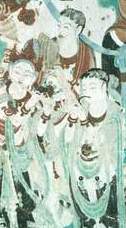|
| Related Stories |
 |
 |
|
|
Preservation and protection of Dunhuang  |
|
|
Preserving the treasure stove has been a hard task for the Chinese scientists and their foreign colleagues since the site is constantly threatened by the environment.
According to Xinhua reports, the interiors of the caves have been severely damaged by wind and water erosion, and some caves have even collapsed. Smoke damage has obscured the murals and centuries of decay has eaten away the painted surfaces.
Scientists have built a monitoring station and a computer data bank to record temperature, sunlight and wind changes both inside and outside the grottoes and have had some success in preserving and recreating the murals by using computers.
Fighting against the sand

Each year, 3,000 to 4,000 cubic metres of sand settle upon the grottoes. Sand dunes almost buried the lower grottoes.
There was no effective way to fight the sand until the 1990s, when scientists decided on a thorough environmental renewal programme.
Three methods of blocking sand were employed on the periphery of the grottoes. The outer defence line is an 800-metre-long, 10-metre-wide belt of bushes. The belt traps the sand, slowing its ingress.
Triangular nylon traps are used as a second line of defence, with the base of the triangle pointing in the direction of the prevailing wind.
In addition, the edge of the cliff has been grouted to reinforce the cliff.
These devices effectively block drifting sands that come from different directions.
The three methods have reduced the movement of sand into the grotto area by more than 80 per cent. These methods of defence are backed up by a forest belt that is 1,200 metres long and 100 to 200 metres wide.
Preservation of paintings

To protect the paintings, scientists have drilled tiny holes in delaminating blisters and injected an adhesive to secure the pigments to the caves walls. The adhesive used has no harmful effect on the original colours. This technique has been used since the 1960s.
Some of the murals have been badly blackened by sulfur produced by candles that were used to light the caves.
Since the 1970s, chemists have been experimenting to find a suitable detergent to wash off dust and soot. A weak detergent was eventually applied to the murals in 71 caves. The original bright colours of the paintings were revealed and do not seem to have faded or changed during the more than 10 years since their washing.
A project to discover the causes of colour deterioration is now underway. Scientists have analyzed a few hundred samples of pigment, using infrared spectrology and other high-tech equipment. The degradation of white lead, red lead and various pigments is now largely understood.
Tourism protection
However, the biggest threat to the Mogao Grottoes now comes from tourists. With China's opening up, there has been a sudden explosion of visitors to Dunhuang. During the tourist season, the Mogao Grottoes receive 600-700 visitors each day.
Their walking and vehicles cause slight tremors. Exhaust fumes emit corrosive gases. Some of the visitors thoughtlessly touch the murals, and carbon dioxide exhaled by the tourists corrodes the fragile treasures.
In an experiment, researchers found that if 40 visitors stay in a medium-sized cave for half an hour, carbon dioxide inside increases six-fold and the moisture level rises drastically, all of which have a very damaging effect on the murals.
"The opening of the Mogao Grottoes to tourists will cause their further deterioration," said Li Qiqiong, a senior artist from the Dunhuang Research Institute, who has spent 48 years in Dunhuang.
To minimize the bad effects, the Dunhuang Research Institute has formulated strict rules. The caves are not all opened at the same time and the murals are covered with glass screens.
Conservationists have also added new sights around the grottoes in order to disperse tourists.
Besides the 20,000-square-metre Dunhuang Grotto Protection and Exhibition Centre, which contains duplicates of the eight best caves and exhibits from the caves, the institute has restored the lower temple where the Taoist monk Wang Yuanlu lived and found the hidden library as the "Exhibition Hall of The Library Cave."
"The Dunhuang grottoes should not be opened to tourists as a common sight," said Fan Jinshi, the director of the Dunhuang Research Institute. "The number of tourists should be strictly under control."
Further protection
Future protective measures including shock-proofing, waterproofing and digital imaging, which can provide accurate records of further restoration required.
It is certain to be a never-ending task, but conservation scientists from China and around the world are determined to shield the world's largest collection of murals from destruction.
Editor: Rebecca & Ronnie
Source: CCTV.com
|
|









